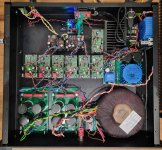What is different between LRCK+/- and normal LRCK (without +/-). The same question is for all other signals. Seems that I2S via RJ45 is more applicable. But there is just one SDATA pin. But for AD1862 we need separate data for left and right.
I'm not sure if can be used glue logic on Miro's board. I have A1862 without shift registers.
As Radian said maybe something like this:
https://www.ebay.com/itm/266307055244
But on this board there is only one DATA pin. I need 2 for left and right channel?
As Radian said maybe something like this:
https://www.ebay.com/itm/266307055244
But on this board there is only one DATA pin. I need 2 for left and right channel?
I don't have Miro's boards but I assume any of his AD1862 boards with shift registers will work.
Now I understand philosophy. Is there sonically any difference in quality between AD1862 boards with and without shift registers ?
Everyone who tried, says it's better directly 🙂 But you have to have supported device like jlsounds i2soverusb that can drive it directly (it has onboard logic).
Just two posts before your initial question about HDMI connection has member PJN comment about MiroDac with and without using shift registers. And I’m sure several other posts dealing with this topic can be found using the search feature. 😉…. Is there sonically any difference in quality between AD1862 boards with and without shift registers ?
Personally, it remains a mystery to me why the sound without shift registers is better, since the sound on the AD1862 originates from LRCK, which is not affected in the case of shift registers, and thus the principle of generation remains the same in both cases 🤔 Could the placebo impression have such a strong impact? 🤣
Not tested by myself, but it should work fine 😉I don't have Miro's boards but I assume any of his AD1862 boards with shift registers will work.
So you don't want to make a separate power supply but use +5V from the USB port?
OK, you are right - so I squeezed in another PSU for the USB part of the JLsounds v3 (the blue transformer in the upper right corner of attached picture). There is a 317 regulator configured for 4.3V (the red PCB with heat sink), under load with the JLsounds connected my DVM reads 4,12V. The DAC sounds even better now (who ever reads this: the difference is absolutely not small, the extra PSU was really a big improvement in my case).
But my questions still remains about the IV resistor: can one of you expert guys please give me some advise about it? The question is: I now use 3K7 as the IV resistor at the end of the IV stage. I use Pedja Rogics discrete non feedback diamond buffer as shown in this schematic. I get a normal output voltage with 3K7, but iirc lower values will result in less distortion - is that the case even if the DAC chip doesn't drive the IV resistor directly?
Attachments
Last edited:
On the same note, would you please share your thoughts on the sound quality of the DAC when FPGA is used instead of logic gates for TDA1541?Personally, it remains a mystery to me why the sound without shift registers is better, since the sound on the AD1862 originates from LRCK, which is not affected in the case of shift registers, and thus the principle of generation remains the same in both cases 🤔 Could the placebo impression have such a strong impact? 🤣
I've got one dead arcam alpha 5 plus with TDA1541A inside, the lens is not working instead of pulling out TDA1541 I was considering of converting it to a CD Player/DAC with output from CD filter going to FPGA and one I2S over USB with a push button the FPGA switches between USB and CD filter.
It depends a lot on the quality of the power supply on the USB port. JLS with 400 or 500mA current consumption is on the limit for USB2.0 ports. It is better to use a 3.0 or later port. Some PCs are better in this regard. Perhaps powering from a USB port would give similar results with an LDO regulator or RC/LC filtering.The DAC sounds even better now (who ever reads this: the difference is absolutely not small, the extra PSU was really a big improvement in my case).
It makes a lot of difference whether you use the rear or front USB ports on the PC case. They are much worse at the front, probably because of the thin wires that reach them, and at the back they are of better quality because they are soldered directly to the mother board. Some older external HDDs won't even work when I plug them into the front USB port, obviously there is not enough current. I use cables with 2 x USB-A connectors for them, that's how they work.
I tried these Chinese Amanero USB/I2S cards (better version with SITIME oscilators, 32$ a piece). Surprisingly good, considering they don't have an option for separate power supply nor galvanic isolation. Amanero copies give a softer sound than JLS, which many people like. They consume half the current required for JLS cards, maybe that's why they work well with USB2.0 ports. 🤔
Last edited:
What are double blind tests worth when we are not blind but deaf.A properly done blind-test would solve many mysteries, but who do such a thing 🤣

And now, no kidding, everyone claims it sounds better. I haven't personally checked, but I know some that have. Two identical DACs, one with and the other without shift registers. So I'm just assembling one more PCM1702P-K, skipping the shift registers and connecting directly to the JLS.
Last edited:
- Home
- Source & Line
- Digital Line Level
- DAC AD1862: Almost THT, I2S input, NOS, R-2R
